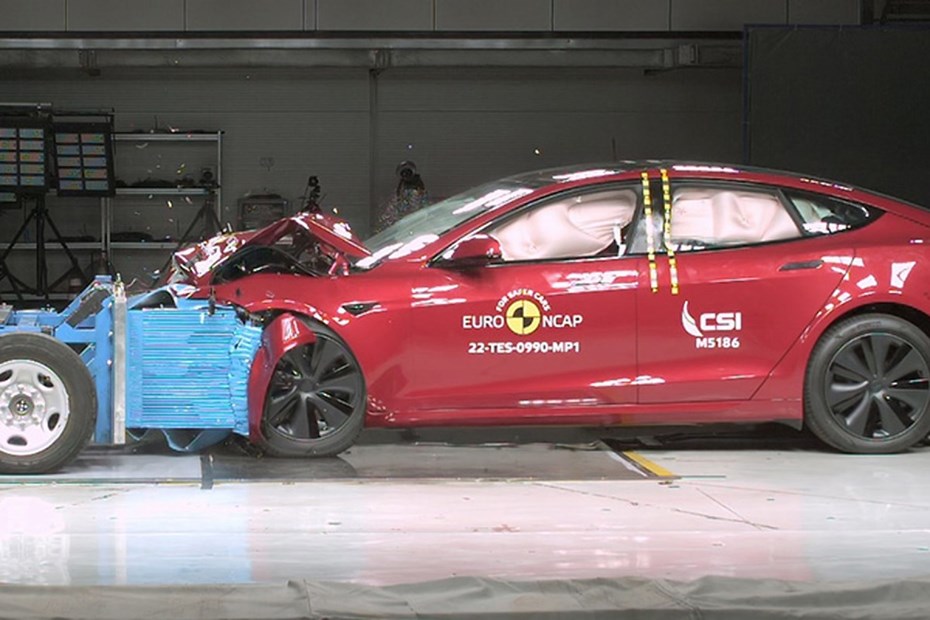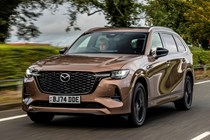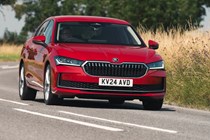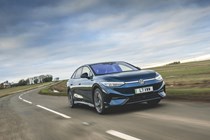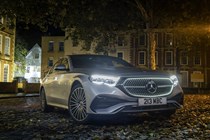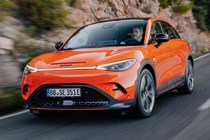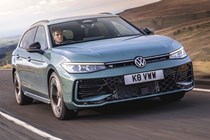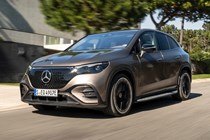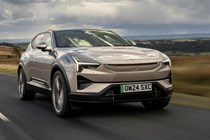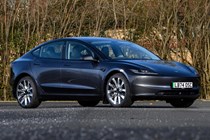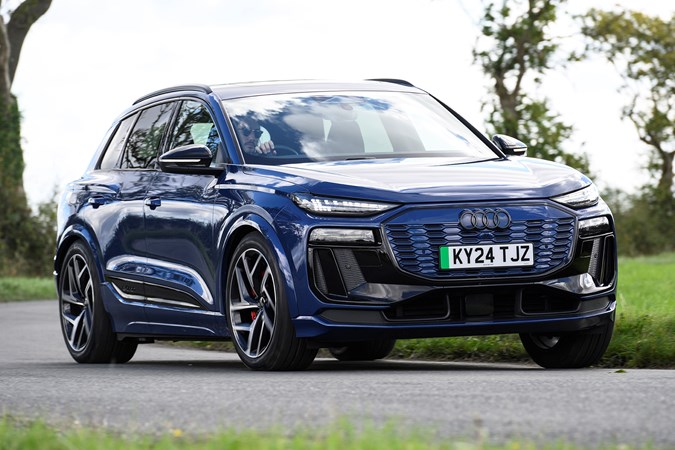Safety is a really important factor to consider when buying a new car, especially if you’re looking for a family car. Thankfully, the experts at Euro NCAP take the guesswork out of finding the safest cars by putting lots of them through their paces to see just how safe they are.
Euro NCAP subjects cars to a rigorous series of trials. They’re slammed into barriers and poles, things are fired at them, their seats are removed and jolted around, they’re driven towards obstacles at speed. Once all the testing is done, the numbers are crunched to produce percentage ratings for how well the car protects occupants inside the vehicle and vulnerable road users outside, plus the effectiveness of various safety systems. Those scores determine an overall star rating out of five. We have a page that explains how Euro NCAP operates in more detail.
Here, we’re looking at the top 10 safest cars Euro NCAP has recently tested. They’re all five-star cars put in order of their cumulative scores across the four areas focused on: adult occupant protection, child occupant protection, vulnerable road user protection and driver assists.
Not all five-star cars are created equal. Among them, the highest score for adult occupant protection is 95%, the lowest is 81%. But a car can make up for a comparatively poor performance in one area by doing better in others. Not that 81% is a poor score in the grand scheme – indeed, 80% or more in any area is an excellent performance.
The cars on this list have all been assessed since 2023 when Euro NCAP changed its parameters to put more emphasis on driver assistance technology. The ratings for cars assessed before then are still perfectly valid, but they’re not directly comparable.
We should also note that Euro NCAP has assessed many cars that are available in various countries on the Continent but haven’t made the leap across the Channel yet. We’ve excluded them to keep this list as relevant to you as possible.
Before we get into the top 10, here are the best performing cars in each area Euro NCAP assesses that are available in the UK:
Adult occupant protection: Volkswagen ID.7 (95%)
Child occupant protection: Tesla Model 3, Polestar 3, BYD Sealion 7 (93%)
Vulnerable road user protection: Tesla Model 3 (89%)
Driver assistance: Tesla Model 3, Mercedes-Benz E-Class (87%)
The top 10 safest cars on sale now
Continues Tesla’s strong Euro NCAP record
Teslas always perform exceptionally well in Euro NCAP’s tests and the latest Model 3 – the ‘Highland’ facelift launched in 2024 – has gone straight to the top of the class. The only significant demerits against it are ‘marginal’ child chest protection in the full-width rigid barrier crash test and a half-marks score for the occupant status monitoring system.
Otherwise, the Model 3 puts in an exceptional performance across the board. In particular, it's the joint highest scorer for child protection and the best for vulnerable road user protection. We should note that the effectiveness of Tesla’s controversial Autopilot system wasn’t tested.
To find out more, read our Tesla Model 3 review
Pros
- Responsive, refined driving experience
- Long driving range potential
- Easy-access Supercharger network
Cons
- Looks like a hatchback but isn’t
- Almost all controls on touchscreen
A great saloon packed with safety tech
The latest Mercedes E-Class is the German brand's safest car yet. Euro NCAP praised its exceptional child protection in crash tests, awarding full marks in that assessment. It was only the lack of Isofix points in the front passenger and middle rear seats that let its overall score down.
The E-Class’s adult protection is excellent, too. The minor damage sustained to the dummies suggests they could have walked away from their accidents (if they weren’t made from rubber and aluminium). Plus, the E-Class has a brilliant range of safety technology, that includes some clever automatic emergency braking system and speed assistance systems. If you value safety above all else when shopping for a family car, look no further.
To find out more, rear our Mercedes-Benz E-Class review
Pros
- Generous back seat space
- Clever driver assistance tech
- Impressive PHEV system
Cons
- Steel-sprung cars are harsh
- E200 model feels a little slow
A great long-distance EV for you and your family
We love the ID.7 at Parkers, so much we made it our Large Family Car of the Year for 2025 – and it’s ultra-strong Euro NCAP safety rating backs up our decision. Like all the cars on this list, the ID.7 is great at protecting its passengers, but it’s also loaded with all the safety technology Volkswagen can chuck at a car, including its excellent Travel Assist system.
What makes the ID.7 stand out, though, is how easy it is engage and disengage the tech as required. In our experience, lane assist isn’t particularly useful on Britain’s narrow country roads as the technology will constantly fight you as it tries to determine where the (often non-existent) white lines are. But the ID.7 has a hot key on its infotainment system that lets you turn off lane assist with a single prod.
To find out more, read our Volkswagen ID.7 review
Pros
- Hugely practical family car
- Claimed 382-mile range
- Comfy on long journeys
Cons
- It’s utterly enormous
- Some interior quality issues
Intriguing and luxurious large electric SUV
We’re used to thinking of Volvo as a maker of the safest cars, but its position on this list has been usurped by sister brand Polestar (the highest-ranking Volvo – the EX30 – is down in the 20s). The 3’s comparatively low score for vulnerable road user protection holds it back. The point is reinforced by NCAP describing it as a ‘somewhat aggressive impact partner’ in a head-on collision with another car.
Inside the car, though, you’ll be pretty much fine. The fact it’s only one point behind the ID.7 above on cumulative scores shows just how fine the margins we’re dealing with are.
To find out more, read our Polestar 3 review
Pros
- Feels great to drive
- Interior is a lovely place
- All models have very good range
Cons
- It's a very big car
- With quite a small boot
Smart's had a strong start to its rebrand
After a few years languishing in the doldrums, Smart exploded back onto scene in 2022 thanks to some fresh investment from new parent company, Geely. The #3 is the second car to come from the company’s rebirth – and it’s really rather good. Not only is it quiet, comfortable and very well built, it’s also very safe in an accident.
Like all the best-performing cars, it has a centre airbag to stop front seat occupants from clashing heads in the event of a side-on impact and side curtain airbags to stop your kids whacking into the doors. It also has an extensive suite of safety kit which, although frustrating to use, makes sure you stay alert and in your lane.
To find out more, read our Smart #3 review
Pros
- Quiet and comfortable
- Well-built and spacious
- Quick charging technology
Cons
- Frustrating safety tech
- Complicated infotainment
Big family SUV that protects families really well
The Q6 e-tron is the first of Audi’s next-generation electric cars – and it’s hit the ground running. Not only is it comfortable, good to drive and packed with impressive technology, it also boasts the highest child occupant safety score of any car tested in 2024 – though it has now been bettered by the Tesla Model 3 and Polestar 3 by a single percentage point.
Why is it so safe? Its body will shield your kids from a crash in the same way a Challenger II tank shields it soldiers from small arms fire, and it's packed with child-focused safety equipment, such as Isofix points in the front and rear, and a child presence detection system that’ll alert you if you leave any kids in the car. That latter piece of tech gives it the edge over its competitors, even if it is a bit daft. What parent forgets to get their kids out of the car?
To find out more, read our Audi Q6 e-tron review
Pros
- Long electric driving range
- Good ride on air suspension
- More polished than any Tesla
Cons
- Generous rear-seat space
- Fiddly touch-sensitive controls
The safest seven-seat SUV tested on the market
The CX-80 was a bit of a rogue move from Mazda. In an age when most manufacturers are ditching their combustion powered cars for EVs, Mazda thought the best course of action was to launch a brand-new, seven-seat SUV powered by a 3.3-litre straight-six diesel.
And it couldn’t have been more right. The CX-80 is a fantastic SUV that’s great to drive, well-made and packed with equipment. And because its massive engine is under stressed, it’s remarkably fuel efficient. If all that wasn’t enough, it’s also the safest seven-seat SUV Euro NCAP has tested under its latest standards, with excellent adult and child occupant protection scores.
To find out more, read our Mazda CX-80 review
Pros
- Spacious and flexible cabin
- High-quality interior finish
- Loads of standard equipment
Cons
- Unrefined PHEV model
- Boot not as useful as rivals'
Czechia’s plucky budget brand beats the big boys
Skoda’s been building five-star cars for a couple of decades now, but the fact the Superb is right up there as one of the safest cars tested in 2024 is testament to how much the brand has matured. The Superb lives up to its name as a very safe car indeed.
It achieved the second-highest score in adult occupant crash tests, and scored very strongly for child occupant protection. The only thing that let the latter score down was its lack of an integrated child restraint system. Its safety technology is a little less comprehensive, but that’s to be expected given its more affordable price.
To find out more, read our Skoda Superb review
Pros
- Immensely practical
- Supremely comfortable
- High-quality interior
Cons
- Gutless mild hybrid engine
- Rivals are more fun to drive
It’s the Superb’s twin – so of course it’s safe
This is a classic case of Volkswagen Group badge engineering. The Passat shares its crash structure and safety technology with the Superb, so it obviously has the same set of Euro NCAP scores. The only real differences between the two cars are the badges on their noses and the amount of money you’ll be expected to hand over to the dealer.
Spoiler alert – the equivalent Skoda Superb estate is £2,600 cheaper. But the Passat has a slightly swankier cabin with more modern touch-sensitive climate controls, which is sure to appeal to tech heads. If you’re looking for the absolute safest option from these two, though, we’d urge you to buy the Skoda. Its traditional climate control dials mean you can spend more time looking at the road.
To find out more, read our Volkswagen Passat review
Pros
- Excellent refinement
- Comfortable ride
- Amazing seat massagers
Cons
- No diesel model
- Annoying luggage cover
One of the best cars on sale for driver assistance tech
Mercedes is making a name for itself in the driver assistance technology game. The latest E-Class jointly holds the best score with the Tesla Model 3 and the EQE SUV placed joint second with the Smart #3. So, if you want a car that does as much thinking for you as possible, you might have found it.
Euro NCAP’s tests also proved it’s a safe companion in an accident (which it should be given its the sheer size), while its extensive suite of driver assistance tech means it should stop you from breezing over any vulnerable road users. It’s just a shame about the rest of the car. Follow the link below to find out why we were left disappointed by it.
To find out more, read our Mercedes EQE SUV review
Pros
- Good interior space
- Responsive touchscreen
- Tidy handling
Cons
- Only five seats
- Lacking polish
The three least safe cars tested since 2023
We’ve included this section for more than a cheap laugh. If you’re buying a new family car, crash performance will be one of your most important considerations. But, as we’ll explain below, you should scrutinise Euro NCAP’s ratings closely. The safety body has placed more emphasis on driver assistance technology in the past couple of years, which has unfairly dragged down the star ratings of cars that do a perfectly good job of protecting their passengers in a crash.
If you’re shopping on a tight budget, it’s likely the cars you’re considering won’t be fitted with loads of safety tech to help keep their starting prices low. So, ask yourself whether the crash safety performance of the car you’re shopping for is satisfactory, whether you can live without the safety tech and, if not, whether you can stretch your budget a little further.
Remember – the very worst way to find out about the safety of your car is after an accident has happened. Go and watch the Dacia Spring’s crash test. It’s an undeniable screamer of a deal, but ask yourself whether you’d be comfortable putting your children in it.
Jeep Avenger
Pitiful pedestrian protection and sub-par safety tech
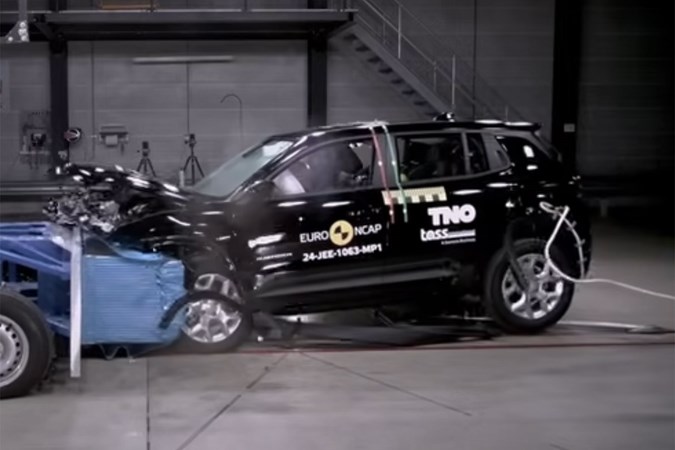

Jeep should be able to do better than this. It has the full engineering might of Stellantis behind it, but the Avenger – Jeep’s biggest seller – has the worst score for driver assistance tech of any car Euro NCAP has tested since 2023. It doesn’t really crash that well, either. It’s the eighth worst for adult occupant protection and the second worst for child occupant protection, behind the Swift.
And, to compound that poor safety performance, it isn’t a particularly good car. It’s uninspiring to drive, it isn’t especially practical, it has an uncomfortable ride, and the electric version isn’t very efficient. If you’re in the market for a small SUV, you can do better.
To find out more, read our Jeep Avenger review
Pros
- Rugged off-road looks
- Efficient petrol engine
- Some off-road ability
Cons
- Average electric range
- Unsettled ride
Suzuki Swift
Affordable supermini, poor crash performance
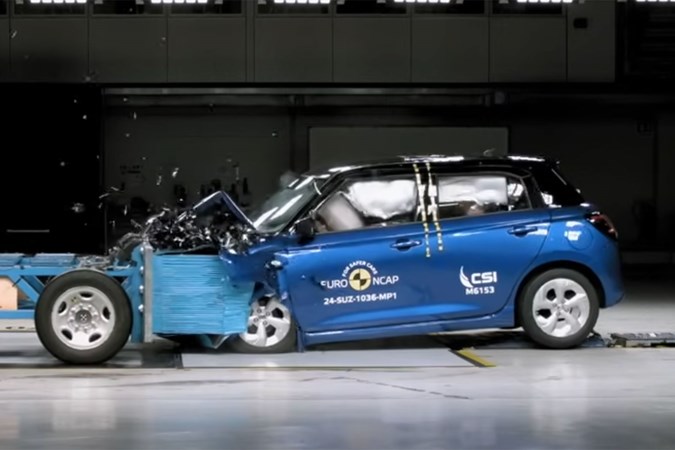

On the surface, the Swift is a very attractive little car. It’s fun to drive, cheap to buy and affordable to run thanks its mild hybrid petrol engine and featherweight construction. But that latter point is its downfall in crash tests, as it has the worst adult and child occupant protection scores of any car Euro NCAP tested since 2023.
Because it’s cheap, it’s driver assistance tech isn’t anywhere near as sophisticated as its more expensive rivals. Its autonomous emergency braking system struggles to recognise pedestrians when turning into junctions and it’s confused when a car approaches it head on. All the more reason to be on the ball when you’re behind the wheel.
To find out more, read our Suzuki Swift review
Pros
- Great fun to drive
- Slick manual gearbox
- Affordable to buy
Cons
- Boot is pretty small
- And it isn't that safe
Dacia Duster
A sad victim of Euro NCAP’s safety tech fixation
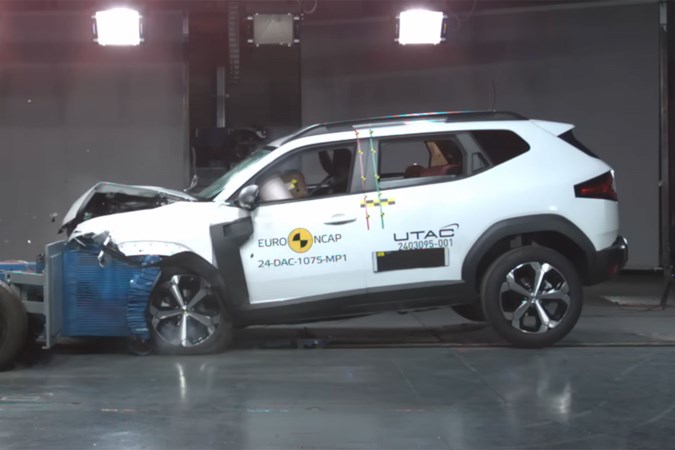

This one seems unfair to us. The Duster crashes well – in fact, its child occupant score is just a few percentage points behind the Skoda Superb and Smart #3 – but, because it only has a simple suite of driver assistance technology, Euro NCAP has penalised it.
Euro NCAP described the Duster’s autonomous emergency braking performance as ‘adequate’ (which seems fair enough to us), but its basic speed assistance system and lack of a driver fatigue monitoring system drags its score down. This a perfect example of why you should scrutinise the safety body’s work. The Duster’s crash structure will protect your family perfectly well in an impact, but it’s technology might not save you getting into an accident in the first place.
To find out more, read our Dacia Duster review
Pros
- Clever, sensible interior
- Hybrid model is efficient
- Neat to drive and good off-road
Cons
- Wind and road noise
- Shallow rear window
Just so you know, we may receive a commission or other compensation from the links on this website - read why you should trust us.


